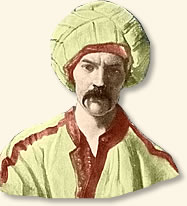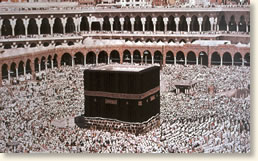|
Entering the Forbidden City
of Mecca, 1853
It was a dangerous journey; any misstep could have cost him his life. In 1853 intrepid British explorer Sir Richard Francis Burton disguised himself as an Islamic pilgrim and made the trek into the heart of Arabia visiting the holy cities of Medina and Mecca. If his true identity as a European Christian had been exposed, the penalty for his indiscretion would have been death.
 |
| Richard Francis Burton |
Mecca was the birthplace of the prophet Mohammed and is the home of the Kaaba,
a small cube-shaped building enclosed within a mosque that is revered as the
holiest site in Islam. In the year 630, Mohammed conquered Mecca and declared
the Kaaba as the center of Islam, requiring that the faithful make a pilgrimage
(the Hajj) to the site at least once in their lifetime. Because of its sacredness,
Mecca became, and remains, a "forbidden city" - off limits to non-Muslims.
It was Burton's plan to disguise himself as a Muslim pilgrim, join the Hajj and enter the holy city. Burton had been preparing for his adventure for years. As a British soldier stationed in India, He had immersed himself in Islam and learned Arabic. In the early 1850s he gained permission to take a leave from the British Army and traveled to Egypt to prepare for his adventure. He immediately took on the disguise of a Muslim, his success prompting him to begin his journey into Arabia in July 1853. He traveled by caravan first to Medina and from there to Mecca. Within a few months he returned to Egypt.
Burton published his description of his journey in a three-volume book that became
an immediate sensation in England. The adventurer was elevated to the status
of folk hero and later enhanced his reputation by beginning an unsuccessful
quest to find the source of the Nile River.
We join Burton's journey as the caravan he is part
of leaves the holy city of Medina on its way to Mecca.
"We dismounted to gaze at the venerable minarets and the green dome which covers the tomb of the Prophet. The heat was dreadful, the climate dangerous, and the beasts died in numbers. Fresh carcasses strewed our way, and were covered by foul vultures. The Caravan was most picturesque. We traveled principally at night, but the camels had to perform the work of goats, and step from block to block of basalt like mountaineers, which being unnatural to them, they kept up a continual piteous moan. The simoom and pillars of sand continually threw them over.
Water is the great trouble of a Caravan journey, and the only remedy is to be patient and not to talk. The first two hours gives you the mastery, but if you drink you cannot stop. Forty-seven miles before we reached Mecca, at EI Zaribah, we had to perform the ceremony of EI Ihram, meaning 'to assume the pilgrim garb'. A barber shaved us, trimmed our moustaches; we bathed and perfumed, and then we put on two new cotton cloths, each six feet long by three and a half broad. It is white, with narrow red strips and fringe, and worn something as you wear it in the baths. Our heads and feet, right shoulder and arm, are exposed.
We had another fight before we got to Mecca, and a splendid camel in front of me was shot through the heart. Our Sherif Zayd was an Arab Chieftain of the purest blood, and very brave. He took two or three hundred men, and charged our attackers. However, they shot many of our dromedaries and camels, and boxes and baggage strewed the place; and whence we were gone the Bedawi would come back, loot the baggage; and eat the camels.
On Saturday, the 10th of September, at one in the morning, there was great excitement in the Caravan, and loud cries of 'Mecca! Mecca! Oh, the Sanctuary, the Sanctuary!' All burst into loud praises and many wept. We reached it next morning, after ten days and nights from EI Medinah. I became the guest of the boy Mohammed, in the house of his mother.
First I did the circumambulation of the Haram. Early next morning I was admitted to the house of our Lord; and we went to the holy well Zemzem, the holy water of Mecca, and then the Ka'abah, in which is inserted the famous black stone, where they say a prayer for the Unity of Allah.
Then I performed the seven circuits round the Ka'abah, called the Tawaf. I then managed to have a way pushed for me through the immense crowd to kiss it. While kissing it, and rubbing hands and forehead upon it, I narrowly observed it, and came away persuaded that it is an aerolite. It is curious that almost all agree upon one point, namely, that the stone is volcanic. Ali Bey calls it mineralogically a 'block of volcanic basalt, whose circumference is sprinkled with little crystals, pointed and straw-like, with rhombs of tile-red felspath upon a dark ground like velvet or charcoal, except one of its protuberances, which is reddish'. It is also described as 'a lava containing several small extraneous particles of a whitish and of a yellowish substance'."
Burton returned to Mecca about a week later and was
able to actually enter the sacred Kaaba.
 |
| the Kaaba |
"A crowd stood gathered round the Ka'abah, and I having no wish to stand bareheaded and barefooted in the midday September sun. At the cry of 'Open a path for the Haji (pilgrim) who would enter the House!' the gazers made way. Two stout Meccans, who stood below the door raised me in their arms, whilst a third drew me from above into the building. At the entrance I was accosted by several officials, dark-looking Meccans, of whom the blackest and plainest was a youth of the,Ben!l Shaybah family, the true blood of the EI Hejaz.. He held in his hand the huge silver-gilt padlock o fthe Ka'abah, and presently, taking his seat upon a kind of wooden press in the left corner of the hall, he officially inquired my name, nation, and other particulars. The replies were satisfactory, and the boy Mohammed was authoritatively ordered to conduct me round the building, and to recite the prayers. I will not deny that, looking at the windowless walls, the officials at the door, and a crowd of excited fanatics below...my feelings were of the trapped-rat description,...A blunder, a hasty action, a misjudged word, a prayer or bow, not strictly the right shibboleth, and my bones would have whitened the desert sand. This did not, however, prevent my carefully observing the scene during our long prayer, and making a rough plan with a pencil upon my white ihram."
References:
This eyewitness account appears in: Burton, Richard Frances, Personal Narrative of a Pilgimage to el Medinah and Meccah (1857); Brodie, Fawn, M., The Devil Drives: a Life of Sir Richard Burton (1967).
How To Cite This Article:
"Entering the Forbidden City of Mecca, 1853", EyeWitness to History, www.eyewitnesstohistory.com (2006).
|






